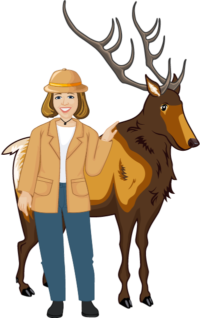Elk Facts
Elk [ĕlk]
Large North American deer with big antlers.

Elk are members of the deer family called Cervidae, which is part of a larger group of mammals called ungulates (mammals with hooves). In North America, there are five species of Cervidae: elk, moose, caribou, white-tailed deer, and mule deer. Of these animals, only caribou do not live in Idaho.
The average elk lives about 20 years. Adults, although rarely hunted by predators, might fall victim to bears, mountain lions, and grey wolves. The calves might be prey for coyotes or bobcats. They protect themselves by living in large herds of up to 400 in number.
Where Do They Live?
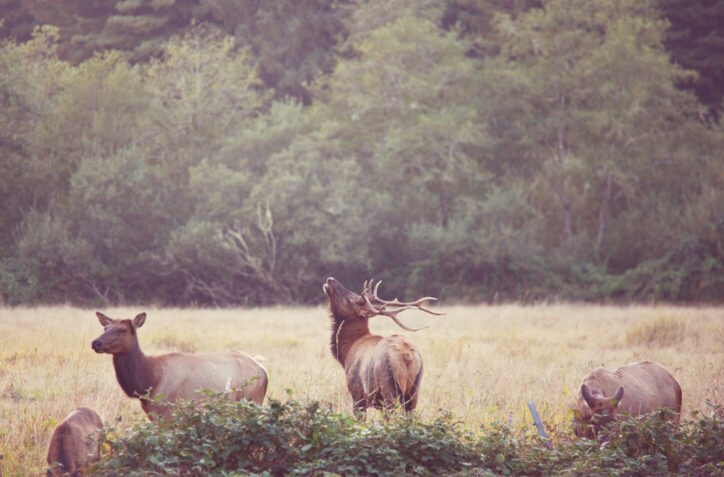
Elk once lived in many areas of the Northern Hemisphere, but excessive hunting and habitat destruction have limited their numbers in North America to largely the western United States and Western Canada. Only Colorado and Montana have more elk than Idaho. Elk have been re-established in areas of Michigan and also introduced to countries such as Argentina, Chile, and Australia, among others.

Elk need food, water, shelter, and space to survive. Elk live all across Idaho, but especially near large meadows where they graze on grasses and the leaves of shrubs and trees. They like meadows that are near forested areas where they can hide when necessary. Elk tend to remain in the trees during the day and venture into the meadows to feed at dawn and dusk.
Elk are herbivores. On average, an elk must eat about three pounds of food per day for every 100 pounds it weighs. This can add up to 20 pounds of food every day! Elk need plenty of space, too. They need to be able to reach their food, water, and shelter easily without human interference. Elk need a healthy habitat and are affected by how many people live in and around that habitat.
Adaptations: Color and Coat

Elk have developed a number of adaptations to help them survive. The Shawnee Indians called the elk Wapiti, which means “white rump.” This is because their hind end tends to be white in color. An elk's coat color is any shade from tan to dark brown depending upon the season. Their necks and legs are usually darker than the rest of their bodies. Bulls (males) tend to be lighter in color than cows (females.) Their color provides them with camouflage.
In addition to helping protect the elk from predators, an elk's coat helps keep it warm or cool depending on the season. Twice a year, elk shed every hair on their body. Their spring shedding is noticeable because old winter hair dangles like long shaggy beards from their necks and sides. By July their winter coat is completely replaced by their summer coat. This coat has just one layer of hair. Longer, darker hair begins appearing on their heads and necks sometime in early September. An elk's winter coat is five times warmer than its summer coat. It consists of two layers — thick, long guard hairs and a dense woolly undercoat. An elk's ability to grow the coat it needs is a type of adaptation for survival.
Adaptations: Life Cycle
Bulls and cows are different sizes. Bull elk can weigh more than 700 pounds. A cow elk can weigh more than 500 pounds. Elk gather in herds that may range from 10 to 400 animals. Living in a herd helps them stay safe from predators.
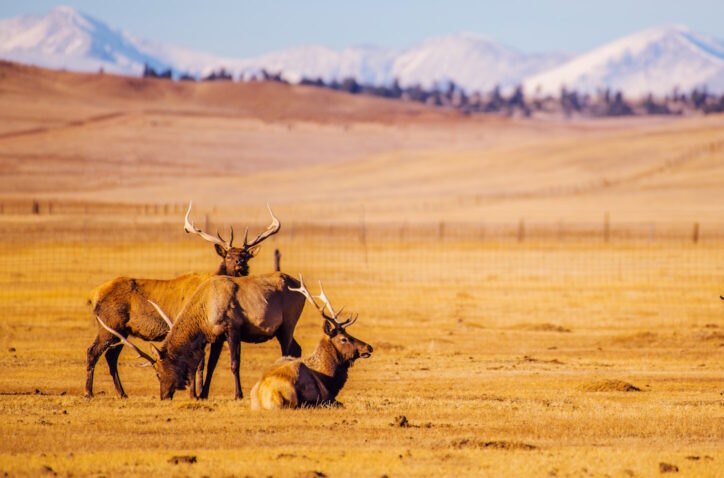
Migration, which is the seasonal movement of animals, is an important part of elk life. During the spring, elk migrate to higher elevations in search of new plants, often following routes that they have traveled before. Elk spend their summers in the mountains where food is abundant and the temperature is cool. During the spring and summer, male and female elk form separate herds. In the fall, snow in the high country gives elk the signal to head to lower elevations. The fall is elk mating season, known as the rut, when male and female herds mix. Bull elk will fight each other to gain control of a group of cow elk known as a harem. They defend the territory around their harem and herd the cows to keep them together.
Elk calves are born from mid-May through early July. Typically a calf weighs about 35 pounds at birth and may gain up to two pounds a day for the next few weeks. A calf is able to stand on its own just 20 minutes after birth. To help it hide from predators, the calf has spots for camouflage and no scent of its own. The mother elk will leave the calf hidden alone for long periods of time to prevent predators from locating the calf by sniffing out the scent of the mother. After about 16 days, the calf is ready to join the larger herd. The cows form a “nursery herd” around the calves to keep them safe.
Adaptations: Antlers
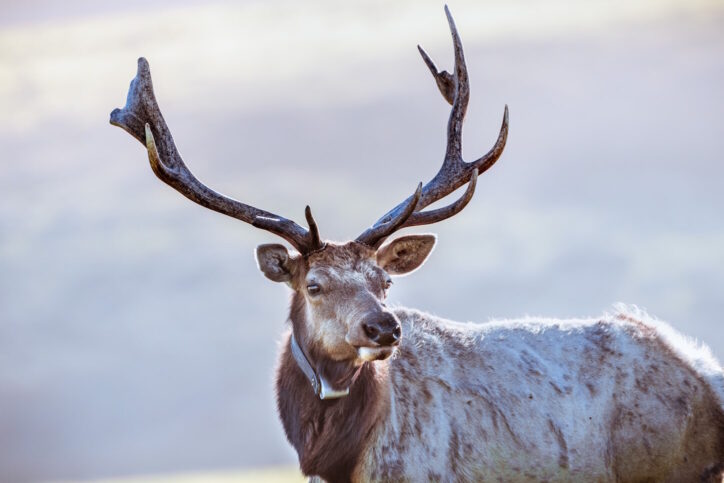
Elk are known for their huge antlers. Antlers are a fascinating adaptation of the deer family. All males of the Cervidae family grow antlers. Caribou females also grow antlers.
Each spring, bull elk begin growing antlers from bony bumps on their heads. It takes an elk four or five months to completely grow a set of antlers. Antlers begin as layer upon layer of cartilage that slowly changes into bone. They are light and easily damaged until late summer when they completely turn into bone.
The antlers are covered with a thin skin called velvet. The velvet is covered with fine, short hairs and contains thousands of blood vessels, which carry calcium and minerals needed for building strong bones. Once the velvet is gone, grooves and ridges on the antlers mark the paths of veins that carry blood throughout the antlers.
Antlers can grow up to one inch a day during the summer — faster than any other type of bone. By summer's end, a set of elk antlers may be as big as 4 feet long and 4 feet wide, and weigh up to 40 pounds. With a full set of antlers, a bull elk can stand 9 feet tall. Antlers are used both to attract females and to battle with other bulls to establish dominance during the fall rut. Bull elk shed their antlers every spring. The antlers fall off after being carried around for six or seven months.
Adaptations: Foraging and Food
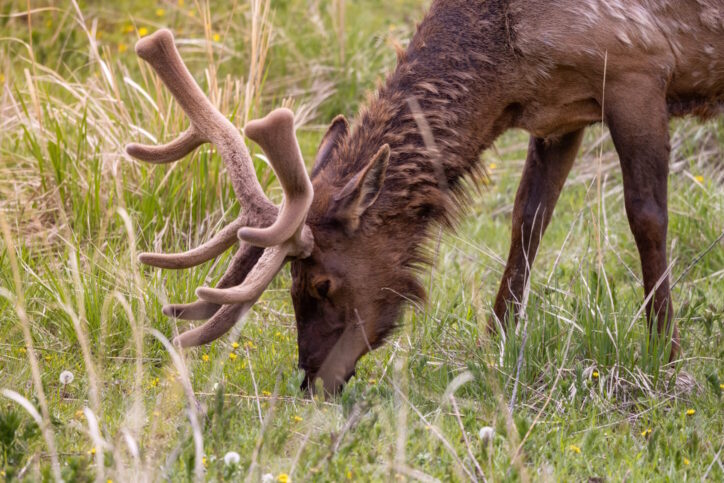
Elk are ruminants, like sheep and cows. This means they digest and re-chew their food by means of a special four-part stomach. To understand how this “super stomach” works, imagine the “unchewed” food an elk eats sliding into a large chamber of the stomach. Here up to 15 pounds of food is stored. Part, but not all, of the food can be broken down.
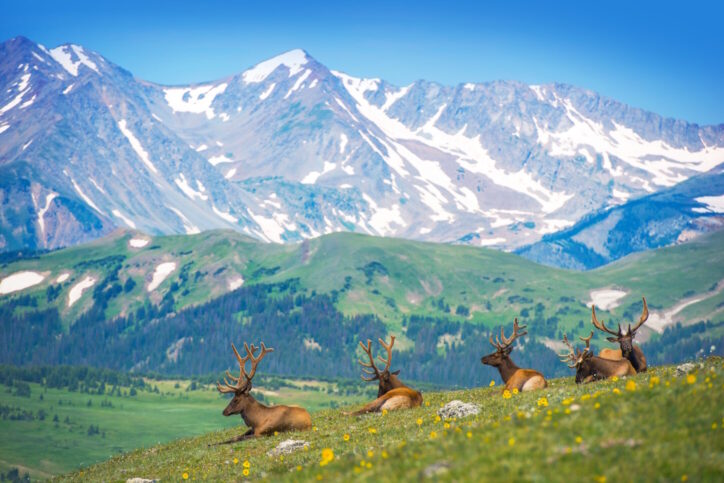
Later, usually when resting, the elk regurgitates or brings that food back up into their mouth. This is known as cud. Chewing cud refers to chewing more thoroughly the food that is brought back up into the mouth. When it is completely chewed, the elk swallows it again. The food particles pass through the large part of the stomach and into a second chamber for even more digestion. Then the food passes into a third chamber where water is squeezed out and absorbed into the elk's body. Finally, the food passes into the fourth “true” stomach where it is broken down to the level that it can be absorbed by the intestines.
Teeth also play an important role in the elk's eating habits. Elk have sharp incisors for biting off plants and flat molars for mashing plants. An elk's top two canine teeth are called ivories, and scientists believe that in the elk's ancient ancestors, these ivories were once actually tusks. Teeth help biologists identify an animal's approximate age. A cross-section of an elk's tooth will show annual growth rings, just like a tree.
Adaptations: Fleetness of Foot
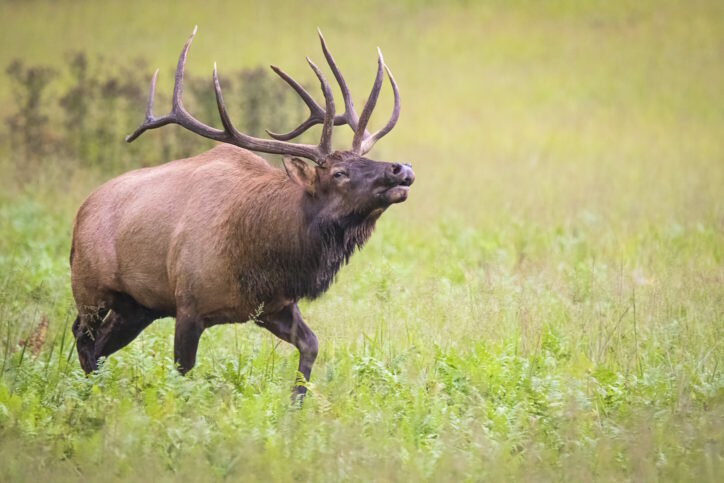
Speed is high on the list of survival needs for an elk. Out-running danger is an elk's best defense against predators. An elk's body is built for speed. Their long legs are packed with muscles that are perfect for running in long, graceful strides. Elk can run up to 45 miles an hour and can even beat horses in short races. In addition, they can jump up to 8 vertical feet.
Adaptations: Sensitive Senses

Before running from danger, an elk must sense the danger is near. Elk have a specialized set of senses which they use to protect themselves and to communicate with each other. Big ears help the elk to hear any noises that might indicate trouble. Eyes located on the sides of their head help them to have a wider range of vision and to sense movement. They can also detect danger and food through their sense of smell.
Elk communicate through various vocalizations. One of their most famous communication methods is their bugle call. During the fall, the males use this call to attract females, to advertise their fitness, and to warn other bulls to stay away. The sound of an elk's bugle call can be heard miles away. The cows and calves also make distinct vocal barks, grunts, and squeals. Visit the National Park Service Sound Gallery website to hear elk calls.
Elk and People
Elk and people have lived in the same habitat for thousands of years. Prehistoric sites have given us clues as to how ancient peoples coexisted with elk.
Elk are painted on rocks throughout archaeological sites in the western United States. These pictographs may have been a form of communication among the people. Some pictographs, however, appear to be decorative.
Native people worked hard to hunt elk. They took only what they needed and used as much of the elk as possible. Elk provided them with meat, weapons and tools, toys, and blankets. There is evidence that elk may have played a spiritual role in the lives of some tribes across the United States.
Today, people enjoy watching, hunting, and photographing elk. Elk have long been a symbol of wilderness to people, and people want to do what is best for them. Although there were once millions of elk in North America, 100 years ago there were less than 50,000 elk remaining, due to overhunting and habitat loss. Through skilled management by wildlife scientists, elk numbers have increased and there are now about one million elk living in the United States and Canada.
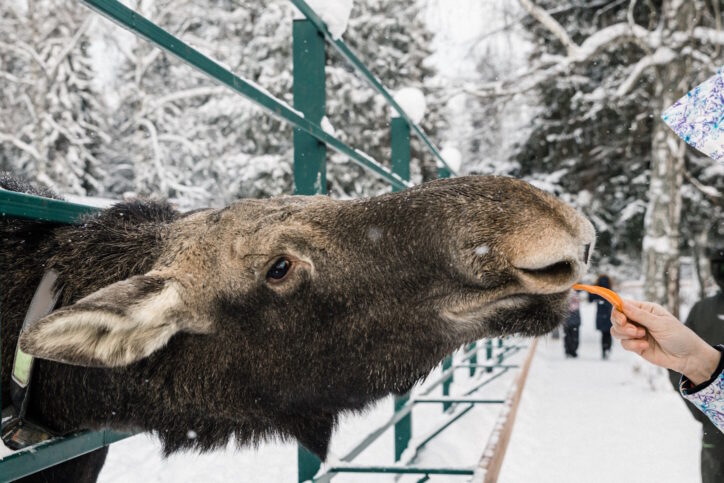
Humans sometimes need to help elk herds survive by protecting their winter migration habitat. The National Elk Refuge in Wyoming provides sanctuary to thousands of elk every winter. In Idaho, elk are sometimes fed by people during a difficult winter. Winter feeding is a term biologists use to describe when humans supply food to wild animals. In areas where winter range has been lost to development, feeding may be necessary to save the herds. Winter feeding can also help keep elk away from private property and busy roads. However, one problem with winter feeding operations is that when animals are crowded together, diseases can spread easily from one animal to another. Also, animals may come to depend on winter feeding and stop migrating to areas where food can be found naturally.
The Idaho Department of Fish and Game's policy on winter feeding is to only feed in emergency situations. They may step in to feed when abnormally high death rates are expected due to extreme winter conditions. Biologists track snow depth, temperature, depredation, animal condition, and other factors to determine whether winter feeding is needed.
Fun Links
Did you know that there is a National Elk Refuge close to Idaho? In Jackson Hole, Wyoming, south of Yellowstone National Park, the elk refuge is home to a magnificent herd of elk. Check out this photo gallery of elk wintering at the National Refuge.
Rocky Mountain Elk Foundation is an organization completely dedicated to elk. Here you will discover all sorts of basic elk facts, see videos, and listen to recordings of elk bugles, barks, and squeals.
Yellowstone National Park is home to many animals including elk. Watch a video and find out where elk are located in the park.
The other North American members of the deer family are also fascinating animals! Become an expert about them by visiting these websites:
• Deer
• Moose
• Caribou
Visit Washington Nature Mapping Program to learn more about Elk.
Learn more details about the elk and listen to an elk call.
Take a look at Wildlife Express: Elk from Idaho Fish and Game. You'll learn a lot about elk and can try a fun crossword puzzle too.
Find out more about winter feeding of elk in Idaho.
Check out Elk Antler Battles! Join the Kratt Brothers to learn about the role that antlers play in the life of elk. Then take a look at this photo gallery of elk antlers from the US Fish and Wildlife Service.
